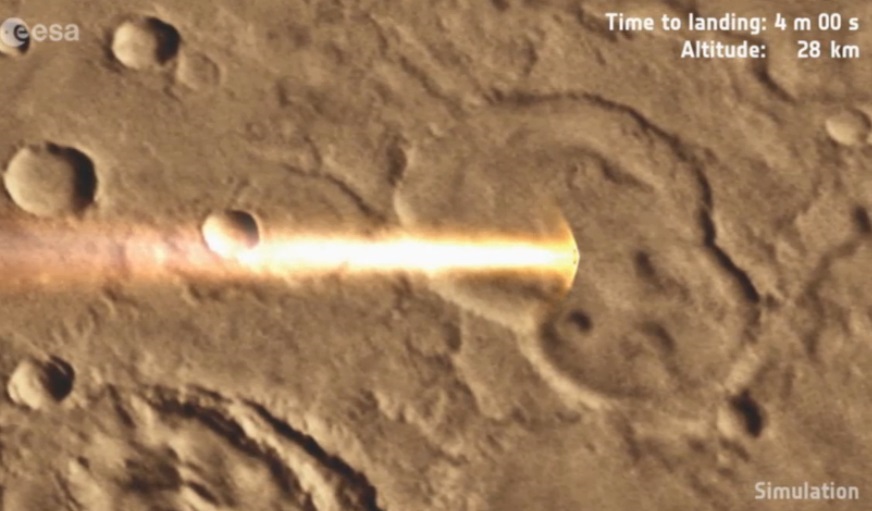 |
Sunday, November 27, 2016
Bad altitude reading leaves ESA with a destroyed lander on Mars
Tuesday, October 18, 2016
Cygnus launches toward the International Space Station
Orbital ATK's Antares rocket carrying Cygnus launched from
Wallops Island, Virginia en route to resupply the International Space Station. Antares carried Cygnus off the pad at 7:46pm EDT igniting its new engines for the first time since the failure back in 2014. Cygnus was separated from the Castor 30XL solid fuel second stage at approximately 7:55pm EDT, 9 minutes after liftoff. Both of the spacecraft's solar arrays were successfully deployed around 9:28PM EDT and is now awaiting to approach the International Space Station. Cygnus has to wait for the new arrival of the 3 new crew members arriving at the station Friday in a Soyuz spacecraft. The station crew members will capture Cygnus and is expected to dock Sunday, around 7:05am EDT.
 |
| Credit: NASA/Bill Ingalls |
Monday, October 17, 2016
Orbital ATK Antares to launch to ISS this afternoon
Orbital ATK is going to launch their Cygnus spacecraft
today aboard the Antares rocket to resupply the International Space Station. Antares will launch from Wallops Island, Virginia at 7:40pm EDT. Cygnus will carry over 5,300lbs of cargo to the ISS. Antares and Cygnus were rolled out to the pad and raised vertically over the weekend and was supposed to launch yesterday but was scrubbed due to an error with a ground equipment cable. 9 minutes after launch, Cygnus will separate from the second stage and deploy its solar arrays about 1 hour and 20 minutes after. Once Cygnus rendezvous, the crew will grapple the spacecraft with the canadarm and dock it to the ISS. After the mission at the station is over, it will undock from the ISS and conduct the Sapphire-2 Space Combustion experiment from NASA's Glenn Research Center to
burn material and study open flames in space. During this time, Cygnus will deploy several small CubeSats from an external NanoRacks deployer. At the end of the mission, Cygnus will conduct a safe reentry over the Atlantic Ocean, completing the mission. All photos credit of Orbital ATK.
Sunday, October 16, 2016
China launches two crew members to Tiangong-2 Station
Thursday, October 6, 2016
Blue Origin tests in-flight abort
On October 5th, Blue Origin launched it's reused New Shepard rocket to test their in-flight abort system for the crew capsule in case something were to go wrong. Video of the in-flight abort test can be viewed here.
Sunday, October 2, 2016
NOAA to launch GOES-R Weather Satellite
 NOAA is going to launch a new weather satellite that will give new High-Definition data for weather predictions. GOES-R will launch aboard an Atlas V rocket into a Geostationary orbit above the US on November 4th at 5:40pm EDT. This data will give a real-time view of the weather in a way we've never seen it before. Some members of the media had a chance to view the Spacecraft before in the Astrotech cleanroom and learn about its functions and the instruments used onboard. They described the upgrade in the imagery as going from Black and White TV to Full HD, so the change is going to be huge.
NOAA is going to launch a new weather satellite that will give new High-Definition data for weather predictions. GOES-R will launch aboard an Atlas V rocket into a Geostationary orbit above the US on November 4th at 5:40pm EDT. This data will give a real-time view of the weather in a way we've never seen it before. Some members of the media had a chance to view the Spacecraft before in the Astrotech cleanroom and learn about its functions and the instruments used onboard. They described the upgrade in the imagery as going from Black and White TV to Full HD, so the change is going to be huge.
Tuesday, September 20, 2016
Next launch to the Space Station by Orbital ATK
| Antares being prepped for launch |
Wednesday, September 14, 2016
Falcon 9 could launch from SpaceX's other launchpads
| Jason-3 set to launch at the VAFB in California on January 17th, 2016 |
Saturday, September 10, 2016
NASA's OSIRIS-REx launches toward the asteroid Bennu
 NASA's OSIRIS-REx launched from Cape Canaveral, Florida on September 8th at 7:05pm EDT. It launched atop an Atlas V rocket with one strap-on solid rocket booster in the 411 configuration. The probe's purpose is to go to the asteroid Bennu and collect a surface sample. The spacecraft has many scientific instruments to learn about the asteroid and monitor it. It has specially designed solar arrays that can gimbal toward the sun and are extended pointed away from the asteroid. OSIRIS-Rex is also one of the few
NASA's OSIRIS-REx launched from Cape Canaveral, Florida on September 8th at 7:05pm EDT. It launched atop an Atlas V rocket with one strap-on solid rocket booster in the 411 configuration. The probe's purpose is to go to the asteroid Bennu and collect a surface sample. The spacecraft has many scientific instruments to learn about the asteroid and monitor it. It has specially designed solar arrays that can gimbal toward the sun and are extended pointed away from the asteroid. OSIRIS-Rex is also one of the fewspacecraft's to have many small thrusters on its body to help with orientation and translation. The surface sample will be taken by an arm on the spacecraft that extends outward. It's a telescoping arm so the surface sampler can touch the surface for about the 3 seconds it needs for the correct amount of it. It releases nitrogen gas to push the regolith or light surface rock, into the sample canisters. It'll put the canister into the sample return capsule and go on its return trip back to Earth, where the capsule will parachute back into Utah and the spacecraft will burn up in the atmosphere. It is planned to return in September of 2023.
Thursday, September 8, 2016
NASA's Historic Spacecraft to launch this evening
 |
| Photo from the Kennedy Space Center Facebook page |
Saturday, September 3, 2016
Falcon 9 explodes during static fire fueling
On September 1st around 9:07am EDT a Falcon 9 rocket with AMOS-6 was fueling for the planned hold down firing of its nine Merlin engines when an anomaly occurred causing the loss of the rocket and the payload that costed around $200 million. A few days before launch, SpaceX raises the launch vehicle vertical and begins fueling it and go through a regular launch sequence. Then, they ignite all nine Merlin engines to ensure that everything is functioning correctly and usually lasts a few seconds. During the fueling process, an explosion occurred around the area where the strongback umbilical connects to the second stage. This caused the tanks to rupture under pressure and
the liquid contents of the second stage ignited and poured down onto the first stage. The structural integrity of the first stage weakened and the tanks ruptured, which caused the second large explosion. The cause of the initial ignition is still unknown, but the SpaceX team is working hard to find the cause so they can return to flight as soon as possible. The explosion of the rocket caused damage to the launch pad and major damage to the strongback. This event is not like what happened during CRS-7 last year when a broken strut caused an overpressurization event in the second stage resulting in the loss of the vehicle and payload. With this also being an issue with the second stage, this creates a larger setback for SpaceX's launch manifest. SES also stated that what happened doesn't change their plans on launching with a recovered booster. SES-10 was set to launch sometime in October, but with damage to the pad and strongback it may be
pushed back. All photos used are credited to US Launch report who also captured this intense video of the explosion. Updates to this anomaly can be found at SpaceX's website here.
the liquid contents of the second stage ignited and poured down onto the first stage. The structural integrity of the first stage weakened and the tanks ruptured, which caused the second large explosion. The cause of the initial ignition is still unknown, but the SpaceX team is working hard to find the cause so they can return to flight as soon as possible. The explosion of the rocket caused damage to the launch pad and major damage to the strongback. This event is not like what happened during CRS-7 last year when a broken strut caused an overpressurization event in the second stage resulting in the loss of the vehicle and payload. With this also being an issue with the second stage, this creates a larger setback for SpaceX's launch manifest. SES also stated that what happened doesn't change their plans on launching with a recovered booster. SES-10 was set to launch sometime in October, but with damage to the pad and strongback it may be
pushed back. All photos used are credited to US Launch report who also captured this intense video of the explosion. Updates to this anomaly can be found at SpaceX's website here.
Subscribe to:
Posts (Atom)
New droneship under construction for SpaceX rocket recovery
"Of Course I Still Love You" positioned in the Atlantic Photo // SpaceX To this date, SpaceX currently has 2 droneships to lan...

-
Photo from the Kennedy Space Center Facebook page Tonight at 7:05pm EDT, NASA's OSIRIS-REx spacecraft will launch from Cape Canavera...
-
Falcon 9 Horizontal at SLC-40 - Credit: Craig Vander Galien // SpaceNews SpaceX was planning the liftoff of the Falcon 9 with Dragon to ...








